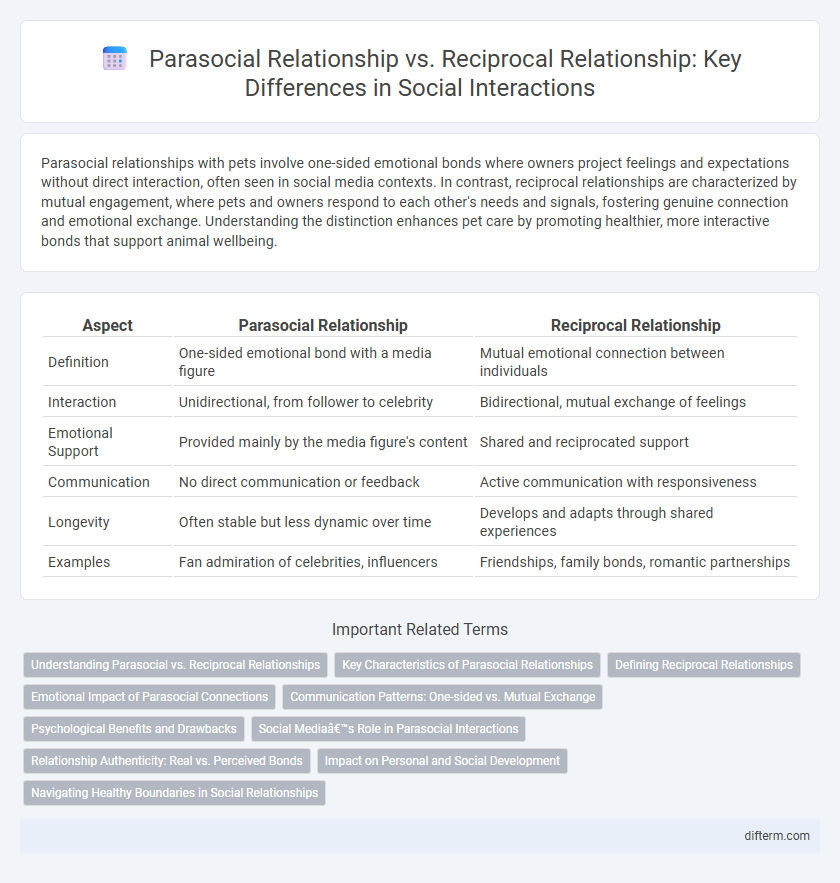Parasocial relationships with pets involve one-sided emotional bonds where owners project feelings and expectations without direct interaction, often seen in social media contexts. In contrast, reciprocal relationships are characterized by mutual engagement, where pets and owners respond to each other's needs and signals, fostering genuine connection and emotional exchange. Understanding the distinction enhances pet care by promoting healthier, more interactive bonds that support animal wellbeing.
Table of Comparison
| Aspect | Parasocial Relationship | Reciprocal Relationship |
|---|---|---|
| Definition | One-sided emotional bond with a media figure | Mutual emotional connection between individuals |
| Interaction | Unidirectional, from follower to celebrity | Bidirectional, mutual exchange of feelings |
| Emotional Support | Provided mainly by the media figure's content | Shared and reciprocated support |
| Communication | No direct communication or feedback | Active communication with responsiveness |
| Longevity | Often stable but less dynamic over time | Develops and adapts through shared experiences |
| Examples | Fan admiration of celebrities, influencers | Friendships, family bonds, romantic partnerships |
Understanding Parasocial vs. Reciprocal Relationships
Parasocial relationships involve one-sided emotional attachments where individuals feel connected to media figures without direct interaction, contrasting with reciprocal relationships characterized by mutual exchange and emotional support. Understanding parasocial vs. reciprocal relationships highlights the impact on social well-being, as parasocial bonds can provide comfort but lack the depth of reciprocity essential for healthy social development. Research indicates that while parasocial interactions fulfill social needs, reciprocal relationships foster stronger emotional resilience and interpersonal growth.
Key Characteristics of Parasocial Relationships
Parasocial relationships are one-sided connections where individuals feel emotionally attached to media figures without direct interaction, often characterized by a lack of mutual exchange and personal feedback. These relationships rely on repeated exposure to media content, creating an illusion of intimacy and familiarity despite the absence of real social reciprocity. Key characteristics include emotional involvement, perceived personal connection, and unidirectional communication, contrasting sharply with the mutual influence found in reciprocal relationships.
Defining Reciprocal Relationships
Reciprocal relationships involve mutual interaction and emotional exchange, where both parties actively engage in communication and support. These relationships are characterized by balanced give-and-take, fostering trust and deeper emotional connections. Unlike parasocial relationships, which are one-sided and often formed with media figures or celebrities, reciprocal relationships depend on equal participation and shared experiences.
Emotional Impact of Parasocial Connections
Parasocial relationships evoke strong emotional responses similar to those in reciprocal relationships, yet they lack mutual interaction and feedback. Fans often experience feelings of attachment, affection, and companionship despite the one-sided nature of these bonds. This emotional impact can influence mental health by providing comfort during loneliness but may also lead to unrealistic expectations and emotional dependence.
Communication Patterns: One-sided vs. Mutual Exchange
Parasocial relationships involve one-sided communication patterns where one party, often a fan or follower, interacts without direct response from the other, such as a celebrity or media figure. Reciprocal relationships feature mutual exchange characterized by two-way communication, emotional sharing, and feedback that strengthen social bonds. The asymmetry in parasocial interactions contrasts sharply with the dynamic, interactive dialogue found in reciprocal relationships, impacting emotional investment and social fulfillment.
Psychological Benefits and Drawbacks
Parasocial relationships offer psychological benefits such as a sense of companionship and emotional comfort without the complexities of mutual interaction, which can reduce feelings of loneliness. However, they lack the reciprocity necessary for deep emotional support, potentially leading to unrealistic expectations and social withdrawal. Reciprocal relationships provide balanced emotional exchange and validation, promoting mental well-being, but they also require effort and vulnerability, which can introduce stress or conflict.
Social Media’s Role in Parasocial Interactions
Social media platforms intensify parasocial relationships by facilitating one-sided interactions where users feel connected to influencers or celebrities without mutual engagement. Algorithms personalize content to sustain continuous exposure, reinforcing emotional attachment despite the lack of direct communication. This dynamic contrasts sharply with reciprocal relationships, which require balanced interaction, mutual recognition, and emotional exchange to develop genuine social bonds.
Relationship Authenticity: Real vs. Perceived Bonds
Parasocial relationships involve one-sided emotional attachments where individuals perceive a bond without mutual interaction, contrasting sharply with reciprocal relationships that feature bidirectional, authentic exchanges fostering genuine connection. Relationship authenticity depends on mutual responsiveness and shared experiences, which parasocial interactions lack, often leading to perceived rather than real emotional bonds. Studies indicate that while parasocial relationships can provide comfort and social support, they do not replace the depth and trust inherent in reciprocal, authentic human connections.
Impact on Personal and Social Development
Parasocial relationships, characterized by one-sided emotional connections with media figures, can influence personal development by providing a sense of companionship and role models, yet often lack the mutual feedback essential for social skill enhancement. In contrast, reciprocal relationships promote social competence, empathy, and emotional regulation through interactive, bidirectional communication, fostering stronger personal growth and community integration. The balance between these relationship types impacts social identity formation and the ability to maintain healthy interpersonal bonds.
Navigating Healthy Boundaries in Social Relationships
Parasocial relationships involve one-sided emotional connections with media personalities, lacking mutual interaction and reciprocal feedback found in reciprocal relationships. Establishing healthy boundaries requires recognizing the difference between parasocial attachment and genuine social bonds to prevent emotional overinvestment in one-sided connections. Prioritizing face-to-face interactions enhances trust and emotional support, fostering balanced and healthy social relationships.
parasocial relationship vs reciprocal relationship Infographic

 difterm.com
difterm.com